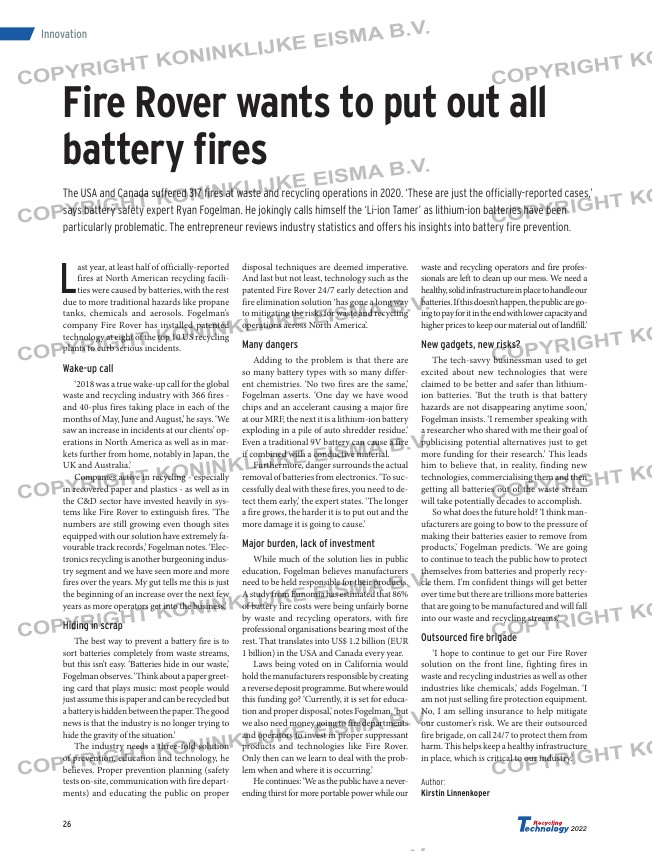Page 26 from: Recycling Technology issue | 2022

26
2022
Innovation
Fire Rover wants to put out all
battery fires
The USA and Canada suffered 317 fires at waste and recycling operations in 2020. ‘These are just the officially-reported cases,’
says battery safety expert Ryan Fogelman. He jokingly calls himself the ‘Li-ion Tamer’ as lithium-ion batteries have been
particularly problematic. The entrepreneur reviews industry statistics and offers his insights into battery fire prevention.
L
ast year, at least half of officially-reported
fires at North American recycling facili-
ties were caused by batteries, with the rest
due to more traditional hazards like propane
tanks, chemicals and aerosols. Fogelman’s
company Fire Rover has installed patented
technology at eight of the top 10 US recycling
plants to curb serious incidents.
Wake-up call
‘2018 was a true wake-up call for the global
waste and recycling industry with 366 fires –
and 40-plus fires taking place in each of the
months of May, June and August,’ he says. ‘We
saw an increase in incidents at our clients’ op-
erations in North America as well as in mar-
kets further from home, notably in Japan, the
UK and Australia.’
Companies active in recycling – especially
in recovered paper and plastics – as well as in
the C&D sector have invested heavily in sys-
tems like Fire Rover to extinguish fires. ‘The
numbers are still growing even though sites
equipped with our solution have extremely fa-
vourable track records,’ Fogelman notes. ‘Elec-
tronics recycling is another burgeoning indus-
try segment and we have seen more and more
fires over the years. My gut tells me this is just
the beginning of an increase over the next few
years as more operators get into the business.’
Hiding in scrap
The best way to prevent a battery fire is to
sort batteries completely from waste streams,
but this isn’t easy. ‘Batteries hide in our waste,’
Fogelman observes. ‘Think about a paper greet-
ing card that plays music: most people would
just assume this is paper and can be recycled but
a battery is hidden between the paper. The good
news is that the industry is no longer trying to
hide the gravity of the situation.’
The industry needs a three-fold solution
of prevention, education and technology, he
believes. Proper prevention planning (safety
tests on-site, communication with fire depart-
ments) and educating the public on proper
disposal techniques are deemed imperative.
And last but not least, technology such as the
patented Fire Rover 24/7 early detection and
fire elimination solution ‘has gone a long way
to mitigating the risks for waste and recycling
operations across North America’.
Many dangers
Adding to the problem is that there are
so many battery types with so many differ-
ent chemistries. ‘No two fires are the same,’
Fogelman asserts. ‘One day we have wood
chips and an accelerant causing a major fire
at our MRF, the next it is a lithium-ion battery
exploding in a pile of auto shredder residue.’
Even a traditional 9V battery can cause a fire
if combined with a conductive material.
Furthermore, danger surrounds the actual
removal of batteries from electronics. ‘To suc-
cessfully deal with these fires, you need to de-
tect them early,’ the expert states. ‘The longer
a fire grows, the harder it is to put out and the
more damage it is going to cause.’
Major burden, lack of investment
While much of the solution lies in public
education, Fogelman believes manufacturers
need to be held responsible for their products.
A study from Eunomia has estimated that 86%
of battery fire costs were being unfairly borne
by waste and recycling operators, with fire
professional organisations bearing most of the
rest. That translates into US$ 1.2 billion (EUR
1 billion) in the USA and Canada every year.
Laws being voted on in California would
hold the manufacturers responsible by creating
a reverse deposit programme. But where would
this funding go? ‘Currently, it is set for educa-
tion and proper disposal,’ notes Fogelman, ‘but
we also need money going to fire departments
and operators to invest in proper suppressant
products and technologies like Fire Rover.
Only then can we learn to deal with the prob-
lem when and where it is occurring.’
He continues: ‘We as the public have a never-
ending thirst for more portable power while our
waste and recycling operators and fire profes-
sionals are left to clean up our mess. We need a
healthy, solid infrastructure in place to handle our
batteries. If this doesn’t happen, the public are go-
ing to pay for it in the end with lower capacity and
higher prices to keep our material out of landfill.’
New gadgets, new risks?
The tech-savvy businessman used to get
excited about new technologies that were
claimed to be better and safer than lithium-
ion batteries. ‘But the truth is that battery
hazards are not disappearing anytime soon,’
Fogelman insists. ‘I remember speaking with
a researcher who shared with me their goal of
publicising potential alternatives just to get
more funding for their research.’ This leads
him to believe that, in reality, finding new
technologies, commercialising them and then
getting all batteries out of the waste stream
will take potentially decades to accomplish.
So what does the future hold? ‘I think man-
ufacturers are going to bow to the pressure of
making their batteries easier to remove from
products,’ Fogelman predicts. ‘We are going
to continue to teach the public how to protect
themselves from batteries and properly recy-
cle them. I’m confident things will get better
over time but there are trillions more batteries
that are going to be manufactured and will fall
into our waste and recycling streams.’
Outsourced fire brigade
‘I hope to continue to get our Fire Rover
solution on the front line, fighting fires in
waste and recycling industries as well as other
industries like chemicals,’ adds Fogelman. ‘I
am not just selling fire protection equipment.
No, I am selling insurance to help mitigate
our customer’s risk. We are their outsourced
fire brigade, on call 24/7 to protect them from
harm. This helps keep a healthy infrastructure
in place, which is critical to our industry.’
Author:
Kirstin Linnenkoper
26-27_batteryfire.indd 26 31-08-21 16:00



